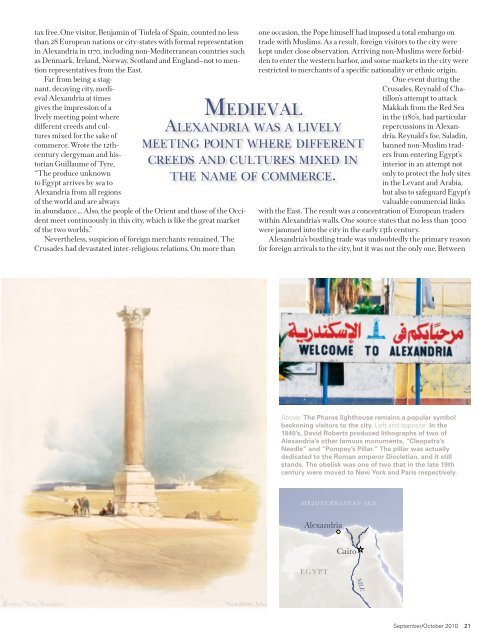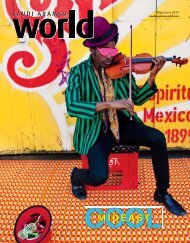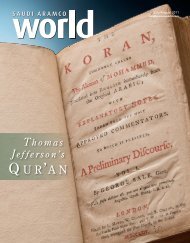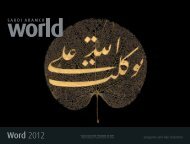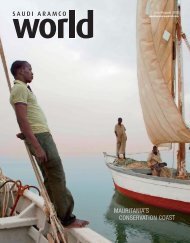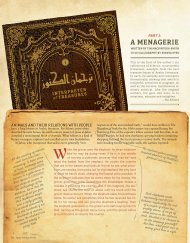ArabicintheSky - Saudi Aramco World
ArabicintheSky - Saudi Aramco World
ArabicintheSky - Saudi Aramco World
Create successful ePaper yourself
Turn your PDF publications into a flip-book with our unique Google optimized e-Paper software.
tax free. One visitor, Benjamin of Tudela of Spain, counted no less<br />
than 28 European nations or city-states with formal representation<br />
in Alexandria in 1170, including non-Mediterranean countries such<br />
as Denmark, Ireland, Norway, Scotland and England—not to mention<br />
representatives from the East.<br />
Far from being a stagnant,<br />
decaying city, medieval<br />
Alexandria at times<br />
gives the impression of a<br />
lively meeting point where<br />
different creeds and cultures<br />
mixed for the sake of<br />
commerce. Wrote the 12thcentury<br />
clergyman and historian<br />
Guillaume of Tyre,<br />
“The produce unknown<br />
to Egypt arrives by sea to<br />
Alexandria from all regions<br />
of the world and are always<br />
in abundance.... Also, the people of the Orient and those of the Occident<br />
meet continuously in this city, which is like the great market<br />
of the two worlds.”<br />
Nevertheless, suspicion of foreign merchants remained. The<br />
Crusades had devastated inter-religious relations. On more than<br />
one occasion, the Pope himself had imposed a total embargo on<br />
trade with Muslims. As a result, foreign visitors to the city were<br />
kept under close observation. Arriving non-Muslims were forbidden<br />
to enter the western harbor, and some markets in the city were<br />
restricted to merchants of a specific nationality or ethnic origin.<br />
One event during the<br />
Crusades, Reynald of Chatillon’s<br />
attempt to attack<br />
Medieval<br />
Alexandria was a lively<br />
meeting point where different<br />
creeds and cultures mixed in<br />
the name of commerce.<br />
Makkah from the Red Sea<br />
in the 1180’s, had particular<br />
repercussions in Alexandria.<br />
Reynald’s foe, Saladin,<br />
banned non-Muslim traders<br />
from entering Egypt’s<br />
interior in an attempt not<br />
only to protect the holy sites<br />
in the Levant and Arabia,<br />
but also to safeguard Egypt’s<br />
valuable commercial links<br />
with the East. The result was a concentration of European traders<br />
within Alexandria’s walls. One source states that no less than 3000<br />
were jammed into the city in the early 13th century.<br />
Alexandria’s bustling trade was undoubtedly the primary reason<br />
for foreign arrivals to the city, but it was not the only one. Between<br />
Danube<br />
Black Sea<br />
Above: The Pharos lighthouse remains L. Tuz a popular symbol<br />
beckoning visitors to the city. Left and opposite: In the<br />
1840’s, David Roberts produced lithographs of two of<br />
Alexandria’s other famous monuments, “Cleopatra’s<br />
Needle” and “Pompey’s Pillar.” The pillar was actually<br />
dedicated to the Roman emperor Diocletian, and it still<br />
stands. The obelisk was one of two that in the late 19th<br />
century were moved to New York and Paris respectively.<br />
Euph<br />
MEDITERRANEAN SEA<br />
Alexandria<br />
Dead Sea<br />
Cairo<br />
EGYPT<br />
NILE<br />
September/October 2010 21


